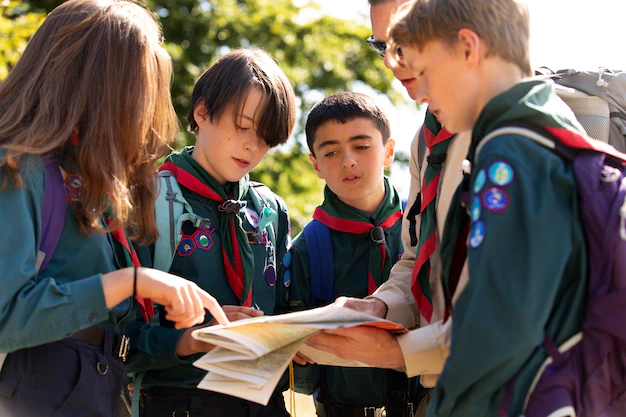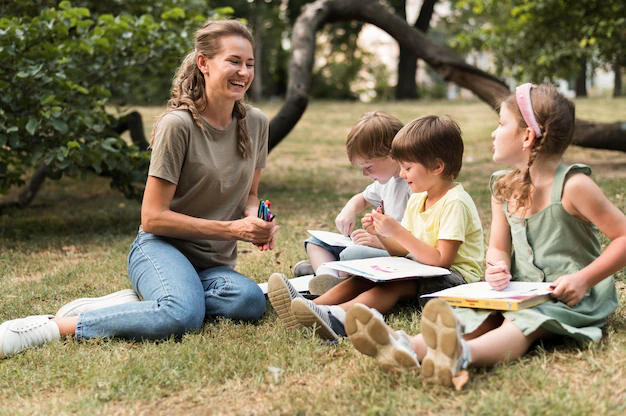Unleashing Creativity and Exploration: Exciting Activities for Outdoor Learning Part 2
Page Contents
- 1 Introduction
- 2 Essential Skills
- 3 A World of Discovery
- 4 Exciting Activities for Outdoor Learning Part 2
- 4.1 31. Outdoor Alphabet and Nature Letters:
- 4.2 32. Natural Building and Fort Construction:
- 4.3 33. Nature Journaling with Poetry and Haikus:
- 4.4 34. Shadow Puppet Shows:
- 4.5 35. Wildflower Identification and Pressing:
- 4.6 36. Outdoor Environmental Surveys:
- 4.7 37. Nature-inspired Math Trails:
- 4.8 38. Rainbow Nature Art:
- 4.9 39. Outdoor Fire Safety and Campfire Cooking:
- 4.10 40. Environmental Art Installations:
- 4.11 41. Nature Story Stones and Storytelling Circles:
- 4.12 42. Outdoor Geography and Map Making:
- 4.13 43. Animal Habitat Creations:
- 4.14 44. Outdoor Observation and Color Matching:
- 4.15 45. Eco-Friendly Crafts and Upcycling:
- 4.16 46. Environmental Theater Productions:
- 4.17 47. Seasons and Nature Changes:
- 4.18 48. Outdoor Mirror Play and Reflections:
- 4.19 49. Outdoor Astronomy and Stargazing:
- 4.20 50. Mud Kitchens and Nature Cooking:
- 4.21 51. Compass and Navigation Challenges:
- 4.22 52. Natural Dyeing and Textile Crafts:
- 4.23 53. Outdoor Balancing and Obstacle Courses:
- 4.24 54. Miniature Eco-system Terrariums:
- 4.25 55. Outdoor Drum Circles and Rhythms:
- 4.26 56. Environmental Role-Playing and Dramatization:
- 4.27 57. Outdoor Math and Nature Weaving:
- 4.28 58. Outdoor Water Exploration and River Studies:
- 4.29 59. Eco-friendly Insect Hotels and Habitats:
- 4.30 60. Outdoor Astronomy Observations and Moon Phases:
- 4.31 61. Nature-inspired Science Experiments:
- 4.32 62. Outdoor Geography and Treasure Hunts:
- 4.33 63. Weather Station and Meteorology Activities:
- 4.34 64. Outdoor Eco-Art Installations:
- 4.35 65. Leaf Rubbings and Nature Patterns:
- 4.36 66. Outdoor Community Service Projects:
- 4.37 67. Solar Energy Experiments and Sun Studies:
- 4.38 68. Outdoor Animal Tracking and Trails:
- 4.39 69. Environmental Debates and Discussions:
- 4.40 70. Natural Disaster Simulations and Preparedness:
- 5 Conclusion
Introduction
Outdoor learning stands as an invaluable tool for fostering curiosity, igniting imagination, and nurturing a profound connection with the natural world. It provides a rich tapestry of experiences that spark exploration and discovery in children. Engaging in activities outside the traditional classroom setting allows young minds to thrive, encouraging a deeper understanding of the environment while promoting holistic development.

Design balance-themed obstacle courses using natural elements. Children develop coordination, balance, and physical agility.
Essential Skills
From scientific explorations to artistic expressions, outdoor learning offers a boundless playground where children can immerse themselves in hands-on experiences, bridging the gap between theoretical knowledge and practical understanding. These diverse activities not only cultivate a sense of wonder but also promote essential skills such as problem-solving skills, creativity skills, teamwork, and environmental stewardship.
A World of Discovery
In this compendium, we explore a spectrum of engaging outdoor learning activities tailored to captivate children’s curiosity and imagination. From nature scavenger hunts to environmental debates, each activity is crafted to inspire, educate, and encourage a deeper connection with nature. By venturing into these outdoor learning adventures, educators and parents open doors to a world of discovery, instilling a love for exploration and a lifelong appreciation for the natural wonders that surround us.
Exciting Activities for Outdoor Learning Part 2
31. Outdoor Alphabet and Nature Letters:
Encourage children to find objects or shapes in nature that resemble alphabet letters. They can create an outdoor alphabet using sticks, leaves, or other natural materials.
32. Natural Building and Fort Construction:
Provide loose materials like branches, logs, or rocks for building forts or natural shelters. This activity promotes teamwork, problem-solving, and creativity.
33. Nature Journaling with Poetry and Haikus:
Combine nature journaling with poetry writing. Children can express their observations and feelings about nature through creative writing, including haikus or descriptive poems.
34. Shadow Puppet Shows:
Utilize sunlight and natural elements to create shadow puppet shows. Children can tell stories or create scenes using their hands and natural light.
35. Wildflower Identification and Pressing:
Collect wildflowers and identify different species. Press flowers between book pages to preserve them and create a collection for identification.
36. Outdoor Environmental Surveys:
Conduct surveys to study the environment. Children can collect data on biodiversity, plant growth, or animal populations in outdoor spaces.
37. Nature-inspired Math Trails:
Create math trails where children solve math problems related to nature. Incorporate counting, measuring, or geometry challenges along the trail.
38. Rainbow Nature Art:
Collect natural materials of different colors (leaves, flowers, stones) and arrange them in rainbow patterns. This activity encourages color recognition and creativity.
39. Outdoor Fire Safety and Campfire Cooking:
Teach fire safety rules and basic cooking skills over a supervised campfire. Children can learn about safety while preparing simple snacks.
40. Environmental Art Installations:
Collaborate to create large-scale art installations using natural materials. This activity encourages teamwork, creativity, and appreciation for the environment.
41. Nature Story Stones and Storytelling Circles:
Paint stones with pictures of animals, plants, or nature scenes. Use these stones as prompts for storytelling sessions in a circle.
42. Outdoor Geography and Map Making:
Create maps of outdoor spaces, marking landmarks, trails, or natural features. Children learn basic mapping skills and geography concepts.
43. Animal Habitat Creations:
Construct miniature animal habitats using natural materials found in the environment. Discuss the specific needs of different animals and their habitats.
44. Outdoor Observation and Color Matching:
Explore the environment to find natural objects that match specific colors. This activity enhances color recognition and observation skills.
45. Eco-Friendly Crafts and Upcycling:
Engage in crafts using recycled or upcycled materials found outdoors. Children create artwork or useful items while learning about sustainability.
46. Environmental Theater Productions:
Script and perform plays with environmental themes or stories centered around nature. Children learn while engaging in creative expression.
47. Seasons and Nature Changes:
Observe and document changes in nature with each season. Children can track seasonal variations, growth cycles, and weather patterns.
48. Outdoor Mirror Play and Reflections:
Use mirrors to explore reflections in nature. Children can observe how light interacts with natural elements, creating reflections and patterns.
49. Outdoor Astronomy and Stargazing:
Explore the night sky and identify constellations or planets. Use telescopes or stargazing apps to enhance astronomical observations.
50. Mud Kitchens and Nature Cooking:
Create outdoor kitchens using natural materials and mud. Children can engage in imaginative play while experimenting with mud-based recipes.
Introduce compasses and navigation skills for outdoor treasure hunts or direction-oriented challenges. This activity promotes spatial awareness and navigation skills.
52. Natural Dyeing and Textile Crafts:
Use natural materials like plants or flowers to create dyes for fabric or paper. Children can experiment with colors and patterns in textile crafts.
53. Outdoor Balancing and Obstacle Courses:
Design balance-themed obstacle courses using natural elements. Children develop coordination, balance, and physical agility.
54. Miniature Eco-system Terrariums:
Create small terrariums using jars or containers. Discuss eco-systems and the interdependence of living organisms.
55. Outdoor Drum Circles and Rhythms:
Use natural materials to create simple drums or percussion instruments. Children can engage in rhythmic activities and explore music outdoors.
56. Environmental Role-Playing and Dramatization:
Role-play scenarios related to environmental issues or ecological conservation. Children learn about environmental responsibility through dramatization.
57. Outdoor Math and Nature Weaving:
Integrate math concepts into nature weaving activities. Children use natural fibers or materials to create patterns and shapes.
58. Outdoor Water Exploration and River Studies:
Explore rivers, streams, or ponds for water-based activities. Children study aquatic life, water flow, and ecological connections.
59. Eco-friendly Insect Hotels and Habitats:
Construct insect hotels or shelters using natural materials. Discuss the importance of insects in the environment.
60. Outdoor Astronomy Observations and Moon Phases:
Study moon phases and observe the moon’s changes over time. Use moon observation to discuss lunar cycles.
61. Nature-inspired Science Experiments:
Conduct science experiments using natural elements. Explore concepts such as water evaporation, seed germination, or the properties of natural materials.
62. Outdoor Geography and Treasure Hunts:
Create geography-themed treasure hunts with clues related to outdoor landmarks or geographical features. Children learn while navigating the outdoor environment.
63. Weather Station and Meteorology Activities:
Set up a weather station to observe and record weather patterns. Children can measure temperature, humidity, or wind direction, fostering an interest in meteorology.
64. Outdoor Eco-Art Installations:
Collaborate to create temporary eco-art installations using biodegradable materials found outdoors. Discuss the concept of art in nature and environmental impact.
65. Leaf Rubbings and Nature Patterns:
Collect leaves and create leaf rubbings using paper and crayons. Children explore patterns and textures found in nature.
66. Outdoor Community Service Projects:
Engage in outdoor community service initiatives such as planting trees, cleaning up natural areas, or creating wildlife habitats to instill a sense of responsibility.
67. Solar Energy Experiments and Sun Studies:
Explore solar energy by conducting simple experiments using sunlight. Children learn about solar power and its applications.
68. Outdoor Animal Tracking and Trails:
Study animal tracks and create trails with markings to mimic animal paths. Children learn about animal behavior and movement patterns.
69. Environmental Debates and Discussions:
Engage in outdoor debates or discussions on environmental issues. Encourage critical thinking and perspective sharing on ecological topics.
70. Natural Disaster Simulations and Preparedness:
Simulate scenarios related to natural disasters. Discuss safety measures and emergency preparedness in natural settings.
Conclusion
These additional outdoor learning activities further enhance children’s opportunities to explore and engage with the natural world. By incorporating a wide range of activities, educators and parents can provide diverse learning experiences that encourage curiosity, critical thinking, and a deeper connection with nature. Outdoor learning fosters holistic development while nurturing a lifelong appreciation for the environment.
These diverse and engaging outdoor learning activities offer children an array of opportunities to explore, learn, and connect with the natural world. By incorporating these activities into educational settings, educators and parents can inspire curiosity, creativity, and a deep appreciation for nature, fostering holistic development in children.







